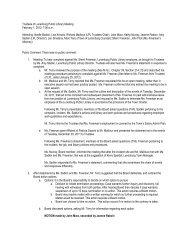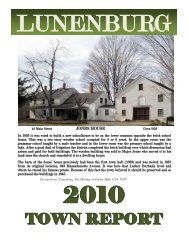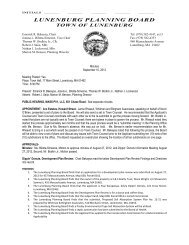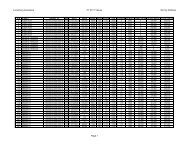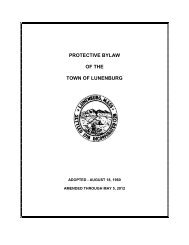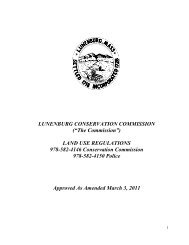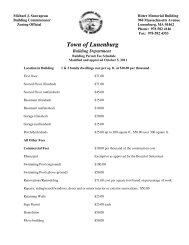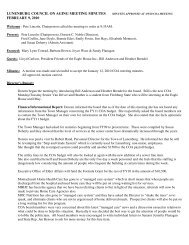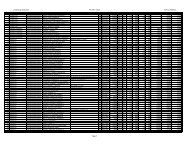T O W N R E P O R T 2007 L U N E N B U R G - Town of Lunenburg
T O W N R E P O R T 2007 L U N E N B U R G - Town of Lunenburg
T O W N R E P O R T 2007 L U N E N B U R G - Town of Lunenburg
- No tags were found...
You also want an ePaper? Increase the reach of your titles
YUMPU automatically turns print PDFs into web optimized ePapers that Google loves.
CENTRAL MASS MOSQUITO CONTROL PROJECTThe Central Massachusetts Mosquito Control Project (the Project) currently provides its services to 39 cities and towns throughoutMiddlesex and Worcester Counties. The Project's headquarters is located at 111 Otis Street. Northboro, MA. Tours <strong>of</strong> theheadquarters or visits to field work Bites may be arranged by calling the <strong>of</strong>fice in advance. Please call 1508) 393-3055 duringbusiness hours for more information. The Project practices Integrated Pest Management (IPM), blending state <strong>of</strong> the art methodsand techniques with expertise, experience, and scientific research to provide our member communities with environmentally soundand coat effective mosquito control. Three 13) new towns joined the CMMCP service area in <strong>2007</strong>, Boylston, Lancaster & Uxbridge.During <strong>2007</strong> the Project received ten thousand, two hundred and ninety four (10,294) requests for service from town residents and<strong>of</strong>ficials. Nearly nine thousand (9,000) pounds <strong>of</strong> Bti (Bacillus thuringiensj.s Israelensis} was applied by helicopter in 3 towns,Chelmsford, Billerica & Boxborough, and five thousand, six hundred and sixty two (5,662) pounds by hand throughout our servicearea were applied to area wetlands to reduce the emergence <strong>of</strong> adult mosquitoes. This represents over two thousand, nine hundredand thirty two (2,932) acres <strong>of</strong> wetland that was treated with this mosquito-specific bacterium, significantly reducing adult mosquitopopulations in these areas. Thirty six thousand, one hundred and sixty five (36,1651 cacch basins were treated with larvicidalproduct to control the mosquitoes that seek out these cool dark wet areas to breed, including the Culex mosquito, a major targetfor West Nile Virus transmission. Three thousand, nine hundred and forty (3,940) culverts were cleaned in an attempt to eliminateUnnecessary standing water and reduce mosquito breeding. This work was done in conjunction with cleaning, clearing, anddigging <strong>of</strong> one hundred and forty six thousand, two hundred and forty (146,240) feet <strong>of</strong> streams, brooks and ditches. Thisrepresents over twenty seven and a half (27.5) miles <strong>of</strong> waterways which were cleaned and improved by project personnel in <strong>2007</strong>.The Mosquito Awareness Program which we <strong>of</strong>fer to elementary schools and other civic organizations in our district hasbecome very popular. Project staff meets with students, teachers or concerned residents to discuss mosquito biology, mosquitohabitat, and control procedures. Much <strong>of</strong> the presentation is directed towards what children and their families can do to preventmosquitoes from breeding around their homes. Slides, videos, coloring books and other handouts make this an interestingprogram. This program is tailored to meet the needs <strong>of</strong> the specific audience. In <strong>2007</strong>, CMMCP laboratory personnel made 48educational presentations before 2,1S2 students in 10 member schools, and CMMCP administrative personnel made 14presentations before 400+ residents to member Boards <strong>of</strong> Health, Selectmen, Conservation Commissions, cable systems, generalpublic meetings and at 3 annual town meetings. CMMCP gave a presentation on our program to 15 Clarke University students in theClarke Vector Ecology program.As part <strong>of</strong> our effort to reduce the need for pesticides we continue to expand our wetlands restoration program. By cleaningclogged and overgrown waterways, mosquito breeding can be reduced and drainage areas are restored to historic conditions. Btimosquito larvicide is used to treat areas where mosquito larvae are found. We routinely check known breeding sites kept in outdatabase, but also encourage the public to notify us <strong>of</strong> any areas they suspect could breed mosquitoes. Our field crews willinvestigate all such requests and treat the area only if surveillance gathered at the time shows an imminent threat <strong>of</strong> mosquitoemergence. Our goal is to manage all mosquito problems with education, wetlands restoration or larviciding, but we recognize thatthere are times when adult mosquito spraying is the only viable solution. In such cases specific areas are treated with either handheldor pickup truck mounted sprayers if surveillance gathered at the time exceeds a pre-determined threshold to warrant anapplication. This program is <strong>of</strong>fered on a request-only basis, and the exclusion process allows residents and/or town <strong>of</strong>ficials toexclude areas under their control from this or any part <strong>of</strong> our program.The Project's surveillance program monitors adult mosquito and larval population density, and is the backbone for prescribingvarious control techniques. Specialized mosquito traps are deployed throughout the Project's service area to sample formosquitoes that may be transmitting mosquito-borne diseases. In conjunction with the Mass. Dept, <strong>of</strong> Public Health we sample inareas suspected <strong>of</strong> harboring WNV and other viruses. One thousand and seventy one (1,071) pools (collections) <strong>of</strong> mosquitoestotaling eleven thousand, nine hundred and ninety two (11,992) specimens were tested for mosquito-borne viruses this year. One(1) pool <strong>of</strong> Cx. pipiens/rescuans complex in Marlborough was confirmed to be infected with the WNV virus and one (1) pool <strong>of</strong> Cx.piplens/restuans complex in Holliston was also confirmed to be infected with the WNV virus. No human cases <strong>of</strong> EEE or WNV wereidentified in our service area, but the City <strong>of</strong> Worcester had one pool confirmed WHV + as well as two • (2) human cases <strong>of</strong> WNV.CMMCP lab personnel made seven thousand, nine hundred and thirty two (7,932) total collections <strong>of</strong> mosquitoes containing thirtynine thousand, four hundred and seventy eight (39,47B) individual specimens, representing twenty eight (231 mosquito species.Some additional highlights from <strong>2007</strong>:• Resistance management study; no significant resistance to pyrethroids noted, no change recommended in adulticide materialchoice (see full report).• Adulticide efficacy; 2-3 days <strong>of</strong> control noted with rebound in mosquito densities to pre-application level (see full report).



